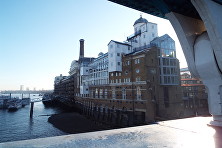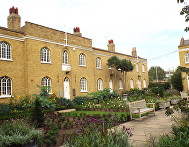





Exploring Southwark and discovering its history



3 June 2017

The Old Mortuary
The Old Mortuary in Rotherhithe is now an active community centre and situated beside St Mary’s Gardens, behind the watch-house. It was built in 1895, replacing an earlier mortuary which, though only built around 1873, was soon considered inadequate. One reason for this was the lack of separate accommodation for those who had died from infectious diseases. Many though died violent deaths and given the dangerous working conditions in the docks and the proximity of the river, many died from drowning, both accidental and suicidal.

A report by the Medical Officer of Health for 1879 recorded 67 inquests of which 41 were deaths by drowning, 18 by street and dock accidents, and the rest occurring in private houses. The entertainer Max Bygraves grew up in Rotherhithe in the 1930s and described the situation in his biography Stars in My Eyes:
“… several times a month a body [was] washed up, then taken to the mortuary, which was about a hundred yards away in St Marychurch Street. These were mostly suicides, people who either couldn’t stand the hardships or lovers who’d decided to end it all. Or it could be they were able-bodied lightermen who might have had a drop too much and missed their footing steering a barge down river. Whatever, these and other flotsam were washed ashore at Rotherhithe because the current went that way.”
…
Modifications were made to the watch-house and used as a temporary mortuary after the older mortuary had been demolished and the new mortuary was in the process of being built. The vestry had tried but failed to secure the use of the mortuary at St Olave’s Infirmary in Lower Road for this period. The mortuary was completed in November 1895 and comprised a non-infectious mortuary, a smaller infectious mortuary, a post mortem room (complete with rotary dissecting table and slate slab table), a room where work with microscopes was undertaken, a viewing lobby and an oak panelled chapel with stained glass windows. In the post mortem room there was an iron girder which can still be seen with a hoist from which bodies brought from the river were suspended to dry out with water draining into a series of channels cut into the floor below.
The mortuary was in use until 1965 and afterwards appears not to have been used much apart from the storage of tools and equipment by Southwark Council Parks Department. In 1980 it took on a new lease of life when it was taken over and refurbished by Time and Talents and turned into a community centre. It runs an active programme that includes an Over 60s Club, an Arts and Crafts Group for the Over 50s, children’s drama, Brownies, a choral society, tai chi and yoga classes, and a neighbourhood care scheme for older people. It is also where the Local History Group meet once a month.
Web discoveries
- UK Casino Not On Gamstop
- UK Casino Not On Gamstop
- Non Gamstop Casino
- Casinos Not On Gamstop
- Non Gamstop Casinos
- Non Gamstop Casinos
- Non Gamstop Casino
- Casinos Not On Gamstop
- Casino Sites Not On Gamstop
- Slots Not On Gamstop
- Casinos Not On Gamstop
- UK Betting Sites Not On Gamstop
- UK Casino Not On Gamstop
- Best Non Gamstop Casinos
- Betting Sites
- Non Gamstop Casino Sites UK
- Best Non Gamstop Casinos
- Non Gamstop Casino
- Casinos Not On Gamstop
- Non Gamstop Casino Sites UK
- Horse Racing Betting